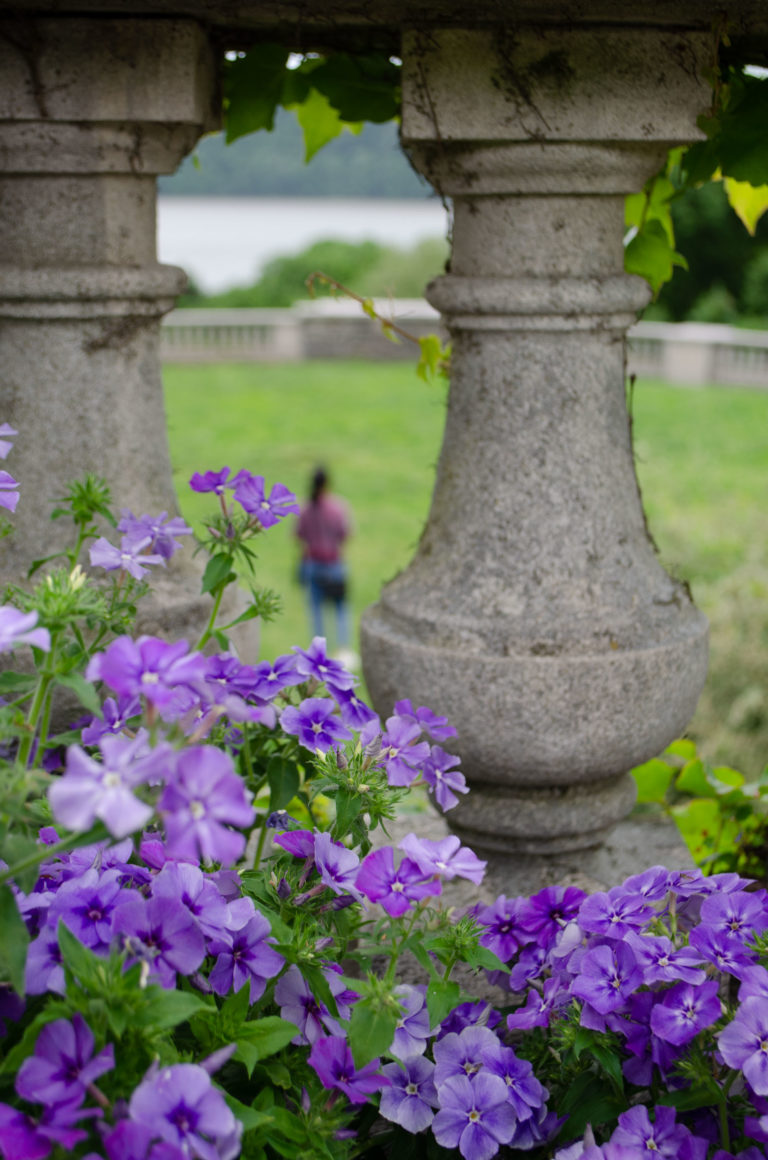
19th Century and the Perkins Legacy
Room to Grow
New York City experienced population growth in the 19th century—the number of New Yorkers doubled twice between 1800 and 1830. That growth, together with the rise of typhus, typhoid and cholera, encouraged many wealthy New Yorkers to begin looking north for homes beyond the city limits.
The Railroad Brings Expansion
The opening of the railway line along the eastern bank of the Hudson River to Cold Spring in 1848 made the area easily accessible from the city and encouraged the development of "villa communities." These planned neighborhoods, a relatively recent aspect of suburban development at that time, preserved the area's natural beauty by encouraging large plots and a limited number of structures. In 1852, a group of New York merchants, headed by WIlliam Woodward, built a villa community north of the Morris land, which named it Riverdale. In 1856, Henry Foster Spaulding and partners began a villa development south of the Morris land, based on a model in New Jersey, Llewellyn Park. The distinctive feature of "The Park-Riverdale," as it was known, was a five-acre parcel set aside for common use as “ornamental pleasure grounds and walks.” This is now New York City-owned Riverdale Park. Spaulding Lane winds down around the southern edge of Wave Hill to meet up with Riverdale Park.

The Empire State Express locomotive ran between New York City and Buffalo. Founded in 1853, New York Central Railroad Company was a consolidation of 10 small railroads that paralleled the Erie Canal between Albany and Buffalo. Photo: Encyclopedia Britannica, Inc.
Notable Tenants

By the closing years of the 19th century, Riverdale had become a year-round residential community. In 1870 and 1871, Appleton's summer villa was leased by the family of Theodore Roosevelt, then a young boy. From 1901 to 1903, Appleton’s heirs leased the house to Samuel Clemens, known to the world as Mark Twain, and his family. A treehouse "parlor" set up in the branches of a chestnut tree was used by Clemens as a writing retreat. In his daughter Clara's book My Father, Mark Twain, she quotes him as saying that “This dining-room is a paradise, with the flooding sunshine, the fire of big logs, the white expanse of cushioned snow and the incomparable river...And how the stormy winds do blow, as the sailor ballad says. I believe we have the noblest roaring blasts here I have ever known on land; they sing their hoarse song through the big tree-tops with a splendid energy that thrills me and stirs me and uplifts me and makes me want to live always.”

Riverdale Defies the Grid
In 1811, a grid pattern was devised for streets and avenues on Manhattan island. When the Bronx was added to New York City—in 1874 and in 1895—the city tried to extend the grid pattern north. The first time, landowners in Riverdale resisted, and invited noted landscape architect Frederick Law Olmsted, who designed Central Park and Prospect Park with his partner Calvert Vaux, to view the landscape here. His report of 1876, authored with city engineer J. James R. Croes, successfully argued that the unusual topography of the land was best suited to an organic street plan following the contour of the terrain rather than a rigid grid.
The Perkins Era Begins
One of the nation’s leading financiers and a pioneer in the field of conservation, midwesterner George Walbridge Perkins and his family first moved to Riverdale in 1893 when, at age 30, he assumed the post of vice president at the New York Life Insurance Company. In 1900, he became a partner of J.P. Morgan and was instrumental in the creation of U.S. Steel and other conglomerates.

An original thinker, Perkins believed that business was a partnership between employers and workers. He introduced progressive ideas into labor relations. Nearing 50, Perkins retired from business to devote himself to public causes. In 1900, then-governor Theodore Roosevelt appointed Perkins to the Palisades Interstate Parks Commission. Perkins joined Theodore Roosevelt in forming the Progressive Party in 1912. He contributed to the management of food supply during World War I and was involved with the Red Cross, Liberty Loans, the United War Work Campaign and the YMCA. George W. Perkins died in 1920, but his widow, Evelina Ball, continued to live at Glyndor until 1960. Their daughter Dorothy and her family lived at Wave Hill House in the 1930s.

Mrs. Perkins surrounded by her children, their spouses and children: clockwise from left are Edward W. Freeman, Dorothy Parker Freeman, Linn Merck Perkins (holding George W. Perkins IV), George W. Perkins III (holding Penelope), Katherine Freeman, Dorothy Freeman and George Edward Freeman (on his father's lap), Evelyn Freeman on Mr.s Perkins' lap.
After George Perkins' death, Evelina carried on his tradition of civic duty. During that time, few major changes were made to the heart of the Wave Hill property. She gave two Victorian villas located below Wave Hill, adjacent to the railroad, to the Riverdale Country School. With the Dodge, Delafield and Douglas families, Mrs. Perkins donated 42 acres of waterfront, above and below the tide line, to New York City. She continued to rent Wave Hill House, which was occupied from 1942 to 1945 by the celebrated conductor Arturo Toscanini. From 1950 to 1956, the house was leased to the British delegation to the United Nations. Harold MacMillan, John Foster Dulles, Konrad Adenaur and even the Queen Mother Elizabeth of England were among the many guests.
The Perkins’s son, George Perkins Jr., shared many of his father’s interests. He held positions in private industry, public service, education and government. He served as assistant secretary of state for European affairs from 194 to 1953 and ambassador to NATO from 1955 to 1957. He continued the work of his father at the Palisades Interstate Parks Commission, serving as secretary, vice president and president.
The Gardens
George Perkins Senior's greatest interest was the gardens. He worked with Albert Millard, a landscape gardener trained in Vienna, carefully engineering all the "natural" paths and gardens, interspersing many rare trees and plants with native species, all in an effort to unify two separate estates. In 1903, he surrounded the property with a low fieldstone wall with wrought-iron entrance gates. In 1906, Perkins added the Palm House, possibly designed by Robert Byers, his personal architect, or, more likely, Lord & Burnham. .

Perkins made extensive changes to the grading and the form of the landscape. This views looks northwest from behind Glyndor II.

The Palm House, shown here in about 1960, was one of two greenhouses Perkins added to the property. Now the Marco Polo Conservatory, it was built in 1906–1907.

Paths and a wood trellis led up to the highest part of the property. Today the Wild Garden, the steps shown here still exist.

This aerial view of Wave Hill House, dating to about 1937, shows the cleared land to the west towards the river, cultivated as vegetable and cutting gardens. Today, those are part of the Herbert and Honja Abrons Woodland.

Perkins's major building project was a large, three-story underground recreation building, now the Ecology Building. Designed by Robert M. Byers in 1909, it included a billiard room, bowling alley and a squash court, as well as a large Adirondack-style gathering room with a stone fireplace. Wall murals depicting southwest Native American life—perhaps Navajo, Hopi or Zuni—are attributed to Howard McCormick. The building is connected to Glyndor House by a tunnel once lined in Guastavino-style tile. Possibly, Perkins planned his building and terrace deliberately in opposition to the proposed grid system for Riverdale. Set into the side of the steep embankment and covered by a landscaped terrace (one of two, tiered terraces), the design of the recreation building was innovative, seamlessly integrating the built environment with the natural and providing a grand platform for enjoying the majestic view.
The Palisades
Across the river, Perkins’s involvement as initiating and founding chairman of the Palisades Interstate Park Commission was pivotal in preserving the Palisades. With support of then New York Governor Theodore Roosevelt, Perkins helped to acquire over 700 acres for the park. The project provided a model for the development of America’s National Park System.

Benjamin Swett
In the 1890s, the cliffs on the west bank of the Hudson were being blasted to pieces by quarrymen and sold as road bedding to feed the fast-growing expansion of the railroad system. Trees were fast coming down as well, for use as lumber. The explosive quarry work caused consternation on both sides of the river, and led to the formation of the Palisades Interstate Parks Commission in 1900. Not long after, Theodore Roosevelt asked Perkins to serve as a member.
Elected chair of the commission, Perkins masterminded the complex, multi-year scheme for buying up individual parcels of land until a complete, 700-acre park was created.
New Era as a Public Institution
In 1960, the Perkins and Freeman families gave the extraordinary gift of the two former residences—Wave Hill House and Glyndor House—and 28 acres to the City of New York to be opened to the public. This magnanimous decision was consistent with the family’s long tradition of public service and George W. Perkins’ personal commitment to conservation. Wave Hill has benefited significantly from the family’s continuing support, governance and interest in the transformation of this institution from a homestead rich in history to an invaluable public resource.
By the time Wave Hill was established as a non-profit and its first horticulturists in place, the gardens had become dilapidated.

Shown here, the old greenhouses, erected a century and half ago by William Henry Appleton. Courtesy Marco Polo Stufano.
Since the mid-1960s the gardens have been transformed, guided by the superb skills of generations of Wave Hill gardeners, beginning with its Founding Director of Horticulture, Marco Polo Stufano. What follows are snapshots of some of the surprising transformations that occurred once Marco Polo Stufano took the reins.

Photo courtesy Massachusetts Horticultural Society.
From the very first day Wave Hill opened to the public in 1967, this garden began to break new ground, figuratively as well as literally. It is no exaggeration to say that over the following decades Wave Hill remade American gardening—as it continues to do today.
Hudson River School
The natural beauty of the area in which Wave Hill is located is so spectacular, it inspired American authors and painters to describe and celebrate our young nation’s distinctiveness. The Hudson River school of painting (1825–1875), which flourished at the same time as William Lewis Morris became interested in the Wave Hill site, is characterized by dramatic American panoramas that depict this scenic landscape. Riverdale's romantically rugged terrain and magnificent vistas provided a sharp contrast to nearby Manhattan's crowded inner city.
A rise in interest in this school of painters since the end of World War II roughly parallels the growth in national awareness of environmental concerns and the evolution of Wave Hill from private estate to public garden.

Sunset on the Hudson by Sanford Robinson Clifford, 1878. Photo courtesy of Wadsworth Atheneum Museum of Art, Hartford, VT. The Ella Gallup Sumner and Mary Caitlin Sumner Collection Fund.




















